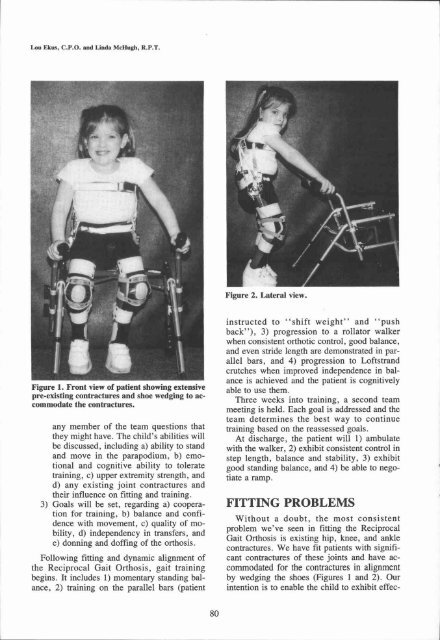View Complete Issue PDF
View Complete Issue PDF
View Complete Issue PDF
Create successful ePaper yourself
Turn your PDF publications into a flip-book with our unique Google optimized e-Paper software.
Figure 2. Lateral view.<br />
Figure 1. Front view of patient showing extensive<br />
pre-existing contractures and shoe wedging to accommodate<br />
the contractures.<br />
any member of the team questions that<br />
they might have. The child's abilities will<br />
be discussed, including a) ability to stand<br />
and move in the parapodium, b) emotional<br />
and cognitive ability to tolerate<br />
training, c) upper extremity strength, and<br />
d) any existing joint contractures and<br />
their influence on fitting and training.<br />
3) Goals will be set, regarding a) cooperation<br />
for training, b) balance and confidence<br />
with movement, c) quality of mobility,<br />
d) independency in transfers, and<br />
e) donning and doffing of the orthosis.<br />
Following fitting and dynamic alignment of<br />
the Reciprocal Gait Orthosis, gait training<br />
begins. It includes 1) momentary standing balance,<br />
2) training on the parallel bars (patient<br />
instructed to "shift weight" and "push<br />
back"), 3) progression to a rollator walker<br />
when consistent orthotic control, good balance,<br />
and even stride length are demonstrated in parallel<br />
bars, and 4) progression to Loftstrand<br />
crutches when improved independence in balance<br />
is achieved and the patient is cognitively<br />
able to use them.<br />
Three weeks into training, a second team<br />
meeting is held. Each goal is addressed and the<br />
team determines the best way to continue<br />
training based on the reassessed goals.<br />
At discharge, the patient will 1) ambulate<br />
with the walker, 2) exhibit consistent control in<br />
step length, balance and stability, 3) exhibit<br />
good standing balance, and 4) be able to negotiate<br />
a ramp.<br />
FITTING PROBLEMS<br />
Without a doubt, the most consistent<br />
problem we've seen in fitting the Reciprocal<br />
Gait Orthosis is existing hip, knee, and ankle<br />
contractures. We have fit patients with significant<br />
contractures of these joints and have accommodated<br />
for the contractures in alignment<br />
by wedging the shoes (Figures 1 and 2). Our<br />
intention is to enable the child to exhibit effec-

















